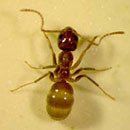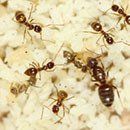A new exotic invasive pest ant species was found around Houston (Harris County), Texas in 2002, and has begun to spread with human assistance. The ant has yet to be identified to species and is commonly referred to as the Rasberry "Tawny" crazy ant "Tawny" crazy ant, Nylanderia sp. nr. pubens (LaPolla, et al). Currently, little is known regarding the biology of this ant. The Center for Urban and Structural Entomology at Texas A&M University is investigating food source attraction, colony growth and immature development. However, research regarding other ant species in the genus, Nylanderia, is available and may offer close approximations for this species.
How Do I Spot Them?
Suspect Rasberry "Tawny" crazy ant crazy ants if you see a lot of ants with the following characteristics:
- Appearance of many (millions) of uniformly-sized 1/8 inch long, reddish-brown ants in the landscape; foraging occurs indoors from outdoor nests.
- Ants that form loose foraging trails as well as forage randomly (non-trailing) and crawl rapidly and erratically (hence the description "crazy" ant).
- Ant colonies (where queens with brood including whitish larvae and pupae, See image on right) occur under landscape objects like rocks, timbers, piles of debris, etc. These ants do not build centralized nests, beds, or mounds, and do not emerge to the surface from nests through central openings.
In Texas, more specifically in the Houston area, the common name being used for Nylanderia sp. nr. pubens is the Rasberry "Tawny" crazy ant crazy ant. The description of the Rasberry "Tawny" crazy ant crazy ant is very similar to the species description for Nylanderia pubens, the Caribbean crazy ant. Research on the correct identification of this ant in Texas, including the morphology and phylogenetic characteristics, is ongoing. Currently, there is no approved common name for this ant by either the Code of Zoological Nomenclature nor the Entomological Society of America.
The crazy ant, P. longicornis, may in some cases create massive, but localized numbers. These species look similar, but have marked differences. Paratrechina longicornis antennae and legs are significantly longer than that of N. sp. nr. pubens. Paratrechina longicornis thorax is extended in length considerably, compared to that of the Nylanderia species. Although the use of color as an identification tool is not to be relied upon, the crazy ant is often jet black in color, especially when compared to the typically reddish-brown of N. sp. nr. pubens.










